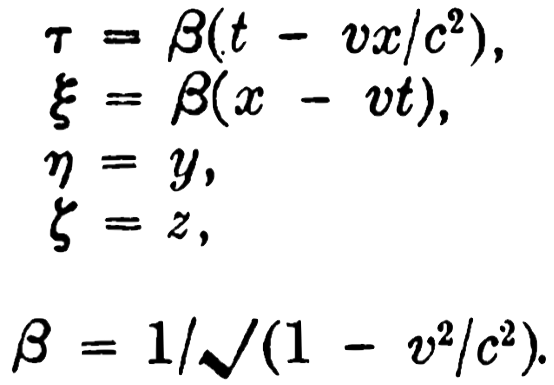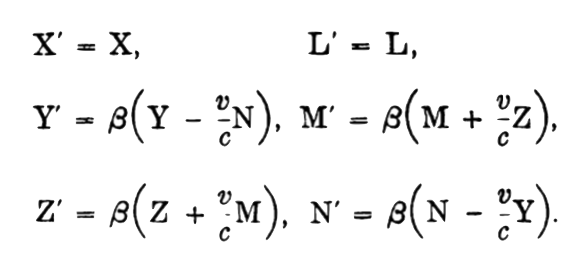HPS
1632 Einstein for Almost Everyone
Fall term 2019
Back to
course document list.
Reading Assignments
Nuggets: A nugget is some item in the reading that strikes you as
noteworthy. It might be a clever remark; or an unexpectedly clever
insight; or just something that piqued your interest.
1. Special Relativity, Part 1.
Read the introduction and I. Kinematical Part (Sections 1 to 4) of A.
Einstein, "On the Electrodynamics of Moving Bodies" In Principle of
Relativity
What is Einstein's statement of the principle of relativity?
What is Einstein's statement of the light postulate?
What are the main results of each section?
For submission:
A nugget
What is the problem outlined in Section 1 about comparing the timing of
events at a point A in space with those of a point B in space?
The most important result of Part I is the Lorentz transformation,
derived in Section 3:

What is represented by the variables t, x, y, z, τ, ξ, η ζ ?
1. Special Relativity, Part 2.
Read: "Chasing the Light:
Einstein's Most Famous Thought Experiment," Thought Experiments
in Philosophy, Science and the Arts, eds., James Robert Brown,
Mélanie Frappier and Letitia Meynell, New York: Routledge, 2013. pp.
123-140.
For submission:
A nugget
In a 19th century ether theory of light, how would a light beam appear
if you chase after it at the speed of light?
A field quantity φ in a plane wave propagating in the x direction has
a time dependency
φ(x, t) = f(x - ct)
for some function f, where c is the speed of light and x and t are the
usual coordinates. The classical "Galilean coordinate transformation is
x' = x-vt, t'=t, y'=y, z'=z,
where the coordinates have their usual meanings and primes denote those
attached to a frame of reference moving at v in the +x direction with
respect to the unprimed frame of reference.
Transform the expression for φ to demonstrate your answer.
(For simplicity, assume φ is a scalar so that φ'=φ.)
1. Special Relativity, Part 3.
Read Section 6 "Transformation of the Maxwell-Hertz Equations for Empty
Free Space..." in II. Electrodynamic Part of A. Einstein, "On the
Electrodynamics of Moving Bodies" In Principle of Relativity.
What are the main results of the section?
What is the point made concerning the "old manner of expression" and "new
manner of expression" a the end of Section 6? (Hint: is there a connection
to the magnet and conductor thought experiment of the introduction?)
For submission:
A nugget
In Einstein's stationary frame of reference "K", the electric field has
components (X, Y, Z) and the magnetic field has components (L, M, N). In
Einstein's inertially moving frame of reference "k," they have
components (X', Y', Z') and (L', M', N') respectively. The Lorentz
transformation equations that relate them are:

How do these equation "mix up" electric and magnetic fields? e.g. start
with a magnetic field but no electric field in k. That is, X'=Y'=Z'=0,
but L', M' and N' need not be zero. What happens when we describe this
situation from the "stationary" frame K?
My answer.
1. Special Relativity, Part 4.
Read Section 7 "Theory of Doppler's Principle and of Aberration." and
"Section 10 "Dynamics of the Slowly Accelerated Electron" in II.
Electrodynamic Part of A. Einstein, "On the Electrodynamics of Moving
Bodies" In Principle of Relativity.
What are the main results of the sections?
What are Doppler's Principle and the effect of [stellar] aberration? Look
them up, if you need to!
How does Einstein arrive at the conclusion in Section 10 that "Velocities
greater than that of light have--as in our previous results--no
possibility of existence."
For submission:
A nugget
We define force in Newtonian physics as "F=ma": force = mass x
acceleration, where a = acceleration = d2/dt2 x.
Sometimes we use a different formulation "F = d/dt (mv)": force = rate
of chance of momentum mv = m(dx/dt). In Newtonian physics, the two
definitions are equivalent.
(a) Show this equivalence
This equivalence fails in relativity theory since mass m(v) changes
with speed v.
(b) Show that the two formulae for force now give different results.
Hint: apply the product rule of
differentiation to F = d/dt(mv) and find an extra term.
(c) Which formula is used by Einstein in his analysis?
Bonus optional hard question: Why does Einstein restrict the analysis
to slowly accelerated electrons? (He does not explain why in the text.)
1. Special Relativity, Part 5
Einstein read philosophers and used their ideas to help him in his
physics. To see one important example, read "How
Hume and Mach Helped Einstein Find Special Relativity." (You have
already seen the content of Section 2, so you can just skim over it.)
For submission
A nugget
The doctrine of operationism says that the meaning of a concept just is
the operations used to measure it. For example to say someone has an IQ
of 120 just means that they score 120 on an IQ test and nothing more.
This doctrine was described in detail after Einstein's work on
relativity by Percy Bridgman. Einstein's work was an important
motivation for him. (For more, if you want it, see
4. Operationism (P. W. Bridgman).)
Read the (short!) Chapter
8 of Einstein's popular text on relativity. How in it does
Einstein give an analysis that would be inspiring to operationists?
1. Special Relativity, Part 6.
A. Einstein, "Does the Inertia of a Body Depend Upon its Energy-Content"
(1905) in Principle of Relativity.
and
Section 1 "A Special Case" in A. Einstein, "The
Principle of Conservation of Motion of the Center of Gravity and the
Inertia of Energy," (1906) Doc. 35 in Einstein Papers, Vol
2.
What precisely is demonstrated in each paper?
For submission
A nugget
The speed of light "c" does not appear in Einstein's 1906 paper. What
symbol does he use for the speed of light?
Describe one difference between the 1905 and 1906 derivations.
2. Minkowski Spacetime
Read Spacetime,
Spacetime and
the Relativity of Simultaneity
and (optionally) Spacetime,
Tachyons, Twins and Clocks
Then take a look at the notes (Notes
on metrical spaces, Notes on
Minkowski spacetime) and see if you can match up the equations in the
notes with qualitative discussion above.
Can you recover these results:
From the Euclidean line element, show that the locus of points
equidistant from the origin in a circle.
From the Minkowski line element, show that the locus of points
equi-interval from the origin is a hyperbola.
For submission
A nugget
Two inertial observers A and B are in relative motion. Draw two
spacetime diagrams that show their worldlines and their associated
hypersurfaces of simultaneity in
(a) a Minkowski spacetime
(b) a Newtonian spacetime
Neatness matters in diagrams. Take trouble to draw figures that are
tidy and convey their content clearly. I will deduct points for hasty or
messy diagrams.
3. General Relativity, Part 1.
Read General
Relativity.
Then take a look at the notes (Notes
on tidal acceleration, Notes on
general relativity) and see if you can match up the equations in the notes
with the qualitative discussion above.
For submission
A nugget
A homogeneous gravitational field has a potential φ=
gx. It
accelerates free bodies in the -
x direction.
The acceleration of such bodies in
the -x direction is given by ax = d2x/dt2
= -∂φ/∂x. Two bodies A and B are located at
different positions in the field and undergo free fall. Show that there is
no acceleration of the distance AB that connects them.
Choose which version to solve:
(easier) Assume that the two bodies
differ only in their x coordinates, which are xA and xB.
Then the acceleration of body A is d2xA/dt2
and that of B is d2xB/dt2. The distance
between the two bodies is dAB = (xA - xB).
To show that there is no relative acceleration, show that d2dAB
/dt2 =0.
OR
(just a little harder) Assume that
the two bodies can be located anywhere in space, so that they have
vectorial positions xA and xB.
Then vector that separates them is dAB = (xA
- xB). Show that this vector is
unaccelerated: d2dAB /dt2
=0.
NB. There is a trap in this
vectorial version. The vector dAB is
unaccelerated in the sense indicated. However the scalar distance dAB
= |dAB | is not unaccelerated.
Neatness matters in proofs. Take the trouble and explain clearly
each step. I will deduct points for hasty or messy work.
3. General Relativity, Part 2.
Read
Then take a look at the notes (
Notes on general relativity) and see if you can match up the
equations in the notes with the qualitative discussion above.
For submission
A nugget
If we ignore the geometric curvature of the spatial sections, the line
element of spacetime in the vicinity of the sun is roughly approximated
by
ds2 = - (c2 + 2φ)dt2 + dx2 +
dy2 + dz2
where the potential φ becomes more negative the closer the we get to the
sun, whose center is at x=y=z=0.
From this line element compute the coordinate velocities of
light dx/dt, dy/dt and dz/dt and show that they are equal.
(How? To find dx/dt, set ds = 0 and also dy=dz=0. Then solve for dx
divided by dt.)
Optional bonus harder question: If the speed of light is same
in all directions near the sun, how it is possible that starlight is
deflected by the sun?
Hint: How does light get refracted in media of varying optical density,
such as when mirages form?
Optional bonus even harder question: why are dx/dt, etc. only
coordinate velocities? How do they differ from "real"
velocities?
Neatness matters...
3. General Relativity, Part 3.
Read Einstein's
Pathway to General Relativity,
Einstein, "Foundation of the General Theory of Relativity," 1916, Part A
Notice how the steps of the history of Einstein's discovery as recounted
in "...Pathway..." reappear as the logical foundation of the theory in
Einstein's 1916 paper.
For submission
A nugget
On p.117 of "Foundation ...," Einstein concludes that "We therefore reach
this result:--In the general of relativity, space and time cannot be
defined in such a way that differences of the spatial co-ordinates can be
directly measured by the unit measuring-rod, or differences in the time
co-ordinate by a standard clock."
How does Einstein arrive at this
conclusion?
How is the problem dealt with in general relativity?
Neatness matters...

